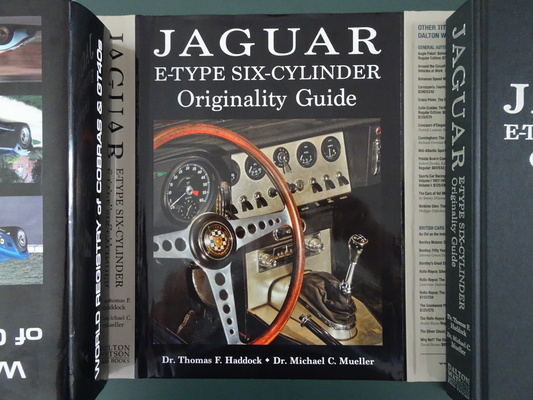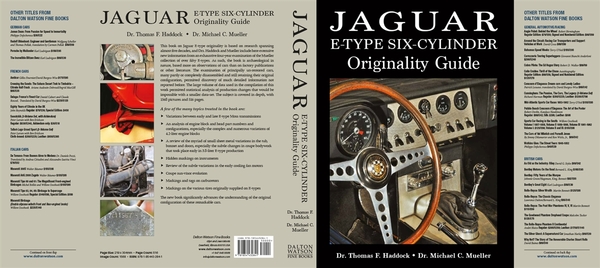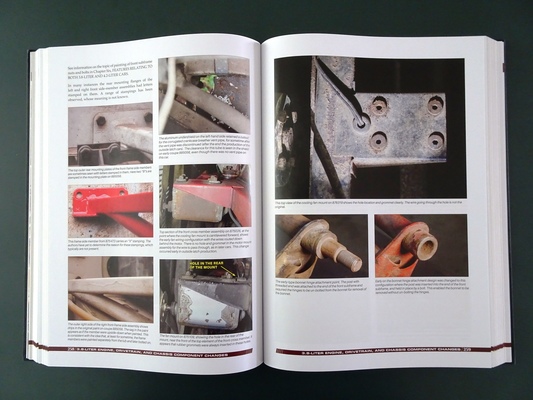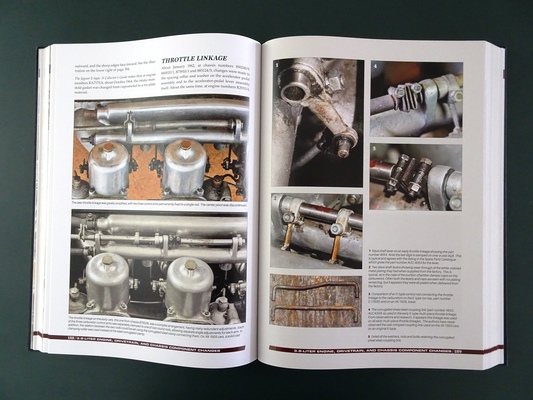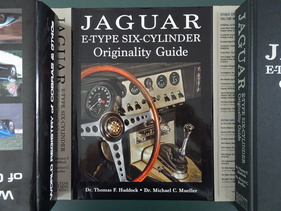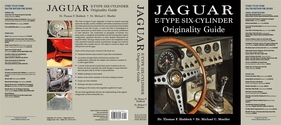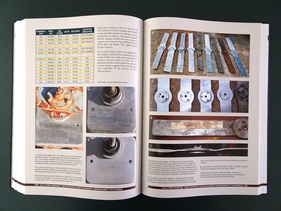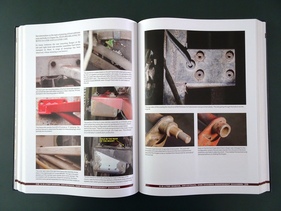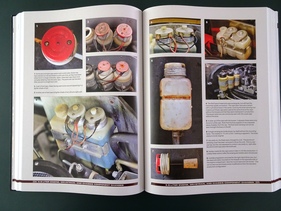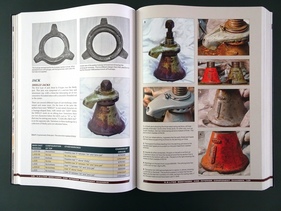"This book on Jaguar E-type originality is based on research spanning almost five decades, and Drs. Haddock and Mueller include here extensive new information from an exhaustive four-year examination of the Mueller collection of over fifty E-types. As such, the book is archaeological in nature, based more on observations of cars than on factory publications or other literature. The examination of principally un-restored cars, many partly or completely disassembled and still retaining their original configuration, permitted discovery of much detailed information not reported before. The large volume of data used in the compilation of this work permitted statistical analysis of production changes that would be impossible with a smaller data-set. It significantly advances the understanding of the original configuration of these remarkable cars" [This book on the original configuration of the Jaguar E-type is based on research carried out over five decades. Dr. Haddock and Dr. Mueller present new information from a comprehensive, four-year investigation of Mueller's collection of over 50 different vehicles. Methodologically an archaeological work, the results are based on observations of the vehicles rather than a study of factory and other literature. The examination of basically unrestored cars, many of them partially or completely disassembled and still in their original condition, led to very detailed information that has not been described before. The large amount of data used to compile the book allowed the statistical analysis of changes in production that would not have been feasible with smaller data sets. It therefore contributes significantly to a better understanding of the original Jaguar E-type].

This is how the book "Jaguar E-type Six-Cylinder Originality Guide" is advertised on the cover. A book that only looks at the six-cylinder models of the E-type, and that only deals with the details of the individual parts of these vehicles? Do we need that? And who should be the buyer, who should be the reader of such a book?
Christian Jenny, honorary member of the Jaguar Drivers' Club Switzerland and himself a major collector of Jaguars, explains: "When my friend Mike Mueller called me from San Antonio in faraway Texas and told me that he and Dr. Thomas Haddock were going to publish a book that was intended as a successor to the former Haddock book Jaguar E-type Six-Cylinder Restoration & Originality Guide [Motorbooks International 1991, ISBN: 978-0-87938-516-3], I was initially surprised. What, the old and long out-of-print Haddock book was finally going to reappear? The book that we enthusiasts had been waiting so long for a new edition of? 'No,' says Mueller, 'together he and Tom have written a completely new book, based on his own collection. Most of them are dismantled, but in almost original condition. Accordingly, they offer excellent illustrative material on the E-types from 1961 to 1971'.
What ended up on my desk, weighing no less than three kilograms, is a work unlike anything we have seen before, even in the very extensive Jaguar literature. Probably the only other Jaguar publication of similar scope, style and quality I could name are the two volumes by Urs Schmid Jaguar XK 120: Anatomie eines Kultobjekts, Volumes 1 and 2 [Vulkan Verlag 2000/2010, ISBN: 978-3-9521878-0-7/978-3-9521878-2-1].
Haddock and Mueller's work is based on research that the two of them have been conducting - first independently, then together for about seven years - on the Jaguar E-type. In English (more precisely: American), with 516 pages, 210x300 mm in size, finely bound with 1,568 photos, practically all in color and in the highest quality. All 6-cylinder models of the E-type are described in detail and even the smallest changes in development are documented with pictures and text.
A work like no other ...
As soon as you start leafing through the book, it becomes clear that both authors have a passion for meticulous research. Only someone who has worked in a methodical research environment for a long time, who has rummaged through scientific works and struggled with the demands on the exactness of a researcher's documentation, is able to venture into the creation of a book like this. Accordingly, the content is invaluable. One must always bear in mind that such detailed findings are not even available from Jaguar today. There would not have been enough time or money for such meticulous documentation during the years of production of the E-type.
... from the world's best E-type specialists
Christian Jenny knows both authors personally: "Both authors are known to me. Dr. Tom Haddock, an economist and management consultant, lives in Wisconsin, USA. I know him from an exciting conversation with Georg Dönni at the Pebble Beach Concours d'Élegance in 2011. I have been friends with Dr. Michael Mueller for years. Until a few years ago, he worked as a surgeon specializing in heart transplants. Today, he is primarily a collector of E-type parts. He also often works as a restorer. He lives in San Antonio, Texas.
Dr. Thomas Haddock is an E-type connoisseur of a special kind, having already published two books in the 1990s: Jaguar E-type Six-Cylinder Restoration & Originality Guide [Motorbooks International 1991, ISBN: 978-0-87938-516-3], and Jaguar E-Type: 6 & 12 Cylinder Restoration Guide [Motorbooks International 2nd edition 1998, ISBN: 978-0-7603-0396-2]. Both books were published as stapled paperbacks and are now out of print. A used copy of the first book currently costs at least CHF 250 and a new or very good copy at least CHF 500.
As one of the most knowledgeable experts on all details of E-types, Tom Haddock began almost 50 years ago to examine all E-types he found anywhere in the USA for their special features, in particular for deviations from the first E-types that came to America. After a long period of fact finding, he was able to recognize what had changed in the course of the model's evolution and with which chassis number. In the former book he even listed which E-types he examined, for example the early E-type convertible 875151 from Christian Jenny in June 1979. The results were and still are a real treasure trove for every passionate connoisseur of E-types, as there was a wealth of information on even the smallest changes. In other words, what the individual components looked like at what time, documented with a wealth of illustrations (albeit only in black and white and often in rather poor quality).
Dr. Michael Mueller probably owns the most unique collection of E-type parts in the world. The scope is breathtaking. The result of an extraordinary life's work. Christian Jenny explains:
"Seven years ago, I had the pleasure of visiting Mike. I had been invited by him to drive out to his ranch on a gloriously sunny Saturday morning.
In the middle of a herd of Texas Longhorns, the cattle we are familiar with from the western movies, there were half a dozen warehouses, barely recognizable at first, hidden between trees and tall grass, in which E-type parts were neatly lined up: passenger compartments of coupés and convertibles as far as the eye could see, stacked on top of each other on different floors, all in such a way that they could be removed with a forklift. Next to them were piles of hoods with pressed-in Louvres, even hoods from the earliest Series 1 with welded-in Louvres, I even discovered a hood with holes in the side for the fasteners, countless subframes for the engine, doors, floor assemblies, everything that belongs to the actual bodywork. Then Mike pushed aside the gate of another warehouse and I entered an Eldorado lined with engine blocks on one side and cylinder heads on the other. Plus, of course, everything that belonged to an engine, such as carburetor assemblies, dynamos and generators, air filter housings and starters. In another warehouse there are all the rear axle assemblies and front wheel suspensions, and in yet another there are radiators, windows and interiors. How many complete E-types can you put together here? I asked somewhat naively. 'I think about seventy down to the last bolt,' came the reply, 'but of course you'll find far more of the most essential parts here, such as engine blocks, cylinder heads, suspensions and everything else that you'd otherwise have to laboriously collect. In short, I had never seen anything quite like it, never seen such an incredible abundance of Jaguar, no, E-type parts. Like every other enthusiast, Mike sometimes seemed downright modest when you think for a moment about everything that is piled up here on the ranch. And what a memory: Mike was probably used to remembering the names of anatomical objects from his medical training, but the fact that there are dozens of part numbers is rather unusual. It was a memorable weekend that I would never have wanted to miss - a practically unused engine block of the greatest importance was found for me in passing.
The book
With their work, Mike Mueller and Tom Haddock have set a standard for assessing the authenticity and originality of any E-type. In the future, it will probably be far more difficult, if not impossible, to make a claim about a component of the E-type that is not properly documented. With the help of countless descriptions and pictures, the book provides solid evidence of what applies to a particular vehicle, which part was installed at the time, what it looked like, which variants there were, which number was stamped on it and how it was installed.
All changes to the body panels, for example, are also shown and described in detail.
Topics relating to the evolution variants, which are discussed in depth in the book, include
- the developments of the early 3.8 lt. E-types
- Variations between early and later Moss gearboxes
- the complex transformations of the 4.2 lt. engine blocks
- the various developments of the body panels of the passenger cell, hoods, doors and trunk lid or coupé rear doors
- Variations of the concealed instrument markings, etc.
Photos are always used to show in as much detail as possible how the mutations occurred over time, with precise details of the date and/or chassis number.
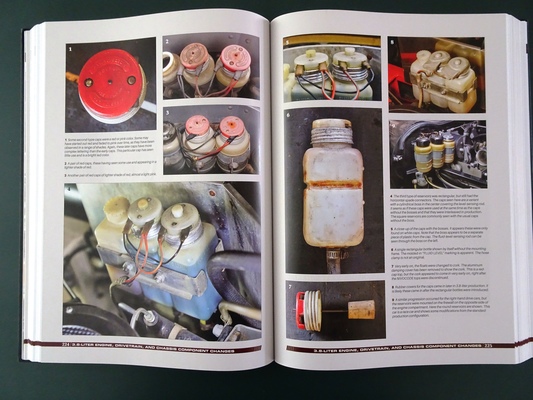
The part numbers are a particular concern; one could say that the work lives from the number classification of the various model series. The following is a good example: The chronological sequence of the variations of the body panels is listed with the corresponding chassis number and shown in pictures. Naturally, it is the early E-types of Series 1 that have undergone the most significant changes (after all, this is when Browns Lane still had the most to learn). In particular, the first "magic" 500 units of the 3.8 lt. model from Series 1, which catch the eye of connoisseurs, are the ones that have received special attention from Mr. Market in recent years. Here are the corresponding chassis numbers:
- RHD Roadster: 850091
- RHD Coupé: 860004
- LHD Roadster: 875385
- LHD Coupé: 885020
The cast-in part numbers on the engine block and cylinder head are meticulously discussed, as are the stamped-in numbers: where are they located and, above all, what is their significance. For example, the cast-in part number on the 3.8-lt. block C 17200 with FF underneath can only be found on the very first E-types, which were still (hand-built) from the Experimental Department.
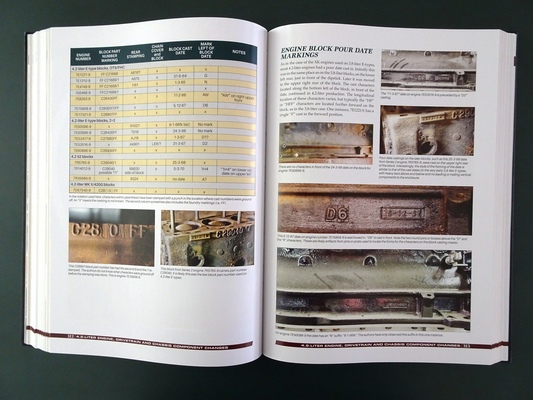
Otherwise the numbers are rather FFC.17523, FFC17523, C20012FF, etc. On the blocks of the 4.2-lt. there are numbers such as C21689FF, C26430FF, C27880FF, C28807FF and C29040FF. This illustrates the precision with which the authors present such information.
Or the ever-present question of the transition to series 1.5 and finally to series 2. What gradual changes occurred in the course of this evolution? First of all, Haddock and Mueller introduce a "Series 1.25", the very late Series 1 vehicles that already had open headlights. These are the following chassis numbers:
- RHD Roadster: 1E1862
- RHD Coupé: 1E31583
- RHD 2+2: 1E50974
- LHD Roadster: 1E14535
- LHD Coupé: 1E34120
- LHD 2+2: 1E77010
Descriptions of the tools for the E-type can also be found in large numbers in Haddock and Mueller's book. For example, the Shelly Jack with three telescopically unscrewable sections is also given due attention and then its replacement, the flat Metallifacture Jack, is described.

Probably two of the most valuable sections from a collector's point of view are the two parts in Appendix 1: 3.8-Liter Changes by Serial Number and 4.2-Liter Changes by Serial Number. These list all the changes that occurred in the evolution of the models by chassis number, or engine or gearbox number.
Who is the book intended for?
The question rightly arises as to who such a comprehensive documentation of parts with all their variations and numbers is actually intended for. There may be many a passionate E-type enthusiast who wonders whether they need to know all this: "I don't care whether my E-type has the right number on the gearbox, whether I have the right dynamo, whether my fuel gauge has the right dial, as long as everything works; what matters to me is that my E-type gives me this special, breathtaking pleasure!".

Christian Jenny emphatically counters such arguments with all sympathy: "No, please don't buy this book, it will only get you into trouble. Instead, look around for the more popular E-type literature. For example, Glen Smale, Jaguar E-type: Porträt einer Design-Ikone [German, Heel Verlag 2008, ISBN: 978-3-86852-027-9]; Paul Skilleter, Der Jaguar E-type: Collectors Guide Band I [German, 2nd ed. Auflage, Heel Verlag 1988, ISBN: 978-3-922858-90-4]; Philip Porter, Jaguar E-type - The Definitive History [English, 2nd Edition, Haynes Publishing 2011, ISBN: 978-0-85733-122-9]; Paul Skilleter, All About The Jaguar E-type [English, PJ Publishing 2010, ISBN: 978-0-9550102-8-6]".
However, for those passionate people who want to delve into the most comprehensive details of their E, this is the book for them. For those who couldn't afford the old Haddock from 1991 (now available second-hand from around CHF 350 and new from around CHF 500), this is for them and, of course, for a wider readership. You can delve into it and find happiness in the fact that the ashtray in your own E is the right one, the tail lights are right and the right voltage regulator is installed. You can also wonder whether you will ever find the correct distributor as shown and described by Haddock/Mueller.
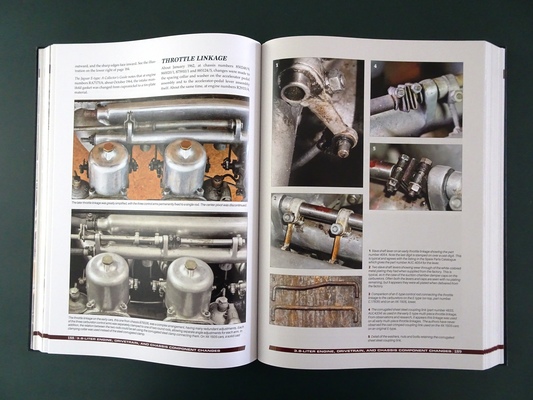
Here's a tip for reading the book: No, lifting three kilograms in bed late at night is hardly recommended. Nor is reading page after page at the dinner table at the witching hour. Instead, Christian Jenny recommends: "Bring a coffee table, a chair, the book, pad and paper, as well as a decent lamp into the garage and place all this right next to your E-type, perhaps a beer or a glass of a special wine, but definitely a good flashlight. And then start with one of the chapters: read, search, compare and make notes. In this way you go through your passion object, experience the satisfaction if it is right, justify yourself internally if it is not, and soon you are left with the satisfaction of really knowing your E-type (or at least to some extent!)".
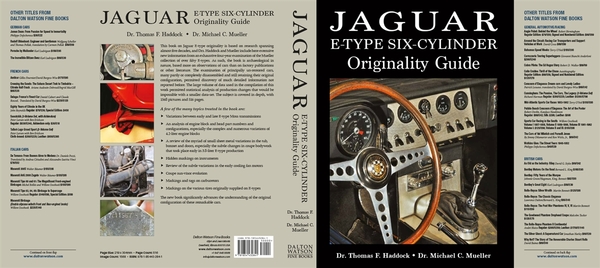
Bibliographic information:
- Title: Jaguar E-type Six-Cylinder Originality Guide
- Authors: Dr. Thomas F. Haddock & Dr. Michael C. Mueller
- Language: English
- Publisher: Dalton Watson Fine Books
- Edition: 1st edition of the extended version 2017
- Format: Hardcover with color cover, 219 x 304mm
- Size: 516 pages, 1,568 mostly color photos
- ISBN number: 978-1-85443-284-1
- Price: CHF 152.00 or from EUR 115.99
- Buy/order: Online in the Dönni Classic Car AG Shop, online at amazon.deor in the relevant book/specialist shops

